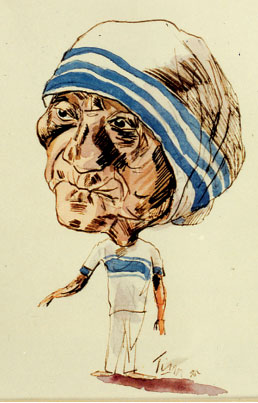|
Learn to draw by Tissa Hewavitarane :
Using different techniques
Brushes can have other than conventional uses. They can stamp or
spatter, drip and dribble. Different types of brushes might be tried,
such as tooth brushes, stencil brushes or house painting brushes. Tools
such as sticks, fingers, palette or knives can be used to apply
watercolour to paper. Other materials can be added to enrich the surface
or the quality of the paint. Colour can also be lifted from a wet
surface, thus making the value lighter. Sponges, paper towels
squeezed-out brushes will do the job. Cardboard and razor blades can
scrape wet colour from the paper.
 |
|
Watercolour line and wash of Mother
Teresa. |
Artists work in a variety of ways at different times. They are
innovators. They love to expand techniques and probe new ways to work.
Their attempt has led to several remarkable techniques. But remember,
none of these artists achieve these techniques overnight - they had to
work hard and have had many hours of trial and error to bring them
successful results.
You must gain enrichment and consequent increased interest in the
painting and develop a series of techniques designed to add texture and
depth to a painting. One method I developed initially from an accidental
discovery. I used a medium weight pressed illustration board generally
considered receptive to watercolour because it lacks the absorbency
required for the medium. Watercolour is one of the few media that stains
into its ground as opposed to being a surface layer of paint; and by
using a non-absorbent material such as illustration board, passages of
paint already down are always subject to being smudged or lifted by
overworking.
This board, however despite its limitations, does have a perfectly
smooth finish to it and allows to get the delicate detail and almost
linear effect by pulling a dry brush stroke across the surface. An
artist can stimulate texture on his drawing paper or can actually adhere
textural material to the surface. He can enrich his watercolour sheet by
blotting, scratching, flicking colour, dabbing, lifting or any other way
that suits his purposes.
Add materials to his surface and thereby produce a richness and
textural quality that is difficult to obtain in any other way.
The illustration shown here is a still study of Mother Teresa in
three colour watercolour wash (in blue and light red) with ink line in
burnt amber.
Notice the expression on her face depicted with pointed number 1
Sable hair brush or thin lines drawn by croquile pen. I have drawn wavy
lines in a repetitive pattern showing highlights, shadows and a few
details. |

